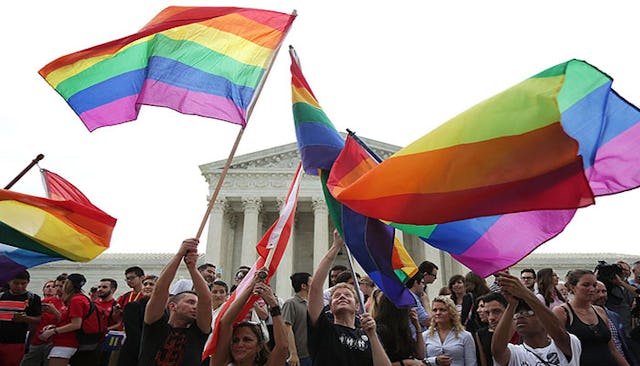Teen Suicide Rates Decreased When Gay Marriage Became Legal

Fewer teens attempted suicide as gay marriage became legal
Breaking news: when LGBT kids aren’t made to feel subhuman, they are less likely to want to end their lives. Huh. Who’da thunk it?
A study published yesterday in JAMA Pediatrics looked at the number of self-reported suicide attempts among 700,000 teenagers between 1999 and 2015. 231,413 of those kids identified as gay, lesbian, or bisexual (the study did not ask if teens identified as transgender or queer.) To put the years of the study in context, here’s a quick reminder of the major dates in the gay marriage equality timeline: the first state to legalize gay marriage was Massachusetts in 2003. 31 other states followed suit, and in 2015 the Supreme Court made it legal nationwide. What the JAMA study found was that prior to 2015, there was a 7% drop in suicide attempts among high school students in the 32 states where same-sex marriage was legal. That percentage increased to 14% among teens who identified as LGB. Since it’s a fairly safe assumption that not all of the teens surveyed were openly gay and that some undoubtedly identified as trans or queer and therefore may not have checked one of the LGB boxes, that percentage was likely higher.
So, just to summarize, when gay, lesbian, and bisexual teens are told that they are not worthy of equal rights and will not be allowed to marry whoever they love because their love is abnormal and unacceptable, they are more likely to consider suicide. But when they are told that they are perfect just as they are, that they can marry whoever they want, and that their love is equal to all love, they are less likely to consider suicide.
It’s like having equal rights is essential to a human being’s sense of worth or something.
But equal rights don’t just affect the people subject to prejudice — it sends a message about a community’s, state’s, or country’s values, and “that could create more tolerance and less bullying, making these teens feel less stigmatized,” as the AP put it.
Laws that have the greatest impact on gay adults may make gay kids feel “more hopeful for the future,” lead author Julia Raifman, a researcher at Johns Hopkins’ Bloomberg School of Public Health, told the Associated Press.
Kids are already vulnerable during the teen and pre-teen years: suicide is the second-leading cause of death among children ages 10-19 (the first is accidents). That’s horrifying enough, but when you look at the difference in rates between LGBT kids and heterosexual kids it becomes clear that our gay children are being very poorly served by this country. The 2015 Youth Risk Behavior Surveillance System found that “more than 29% of gay, lesbian and bisexual high school students nationwide reported attempting suicide within the past 12 months.” Among heterosexual students, that number was 6%.
Twenty-nine percent versus six percent.
It’s unconscionable. And the results of the JAMA study (even though at this point it is still an associative and not causal relationship) shows us the overwhelmingly positive impact that legal gay marriage could be having on our children. Overturning the Supreme Court’s decision will cause kids to die. That’s the bottom line, here. It will be looking LGBTQ kids in the eyes and saying, “You’re not as good as other kids and you never will be. You’re not okay, you don’t deserve the right to marry the person you love.”
So if you want to make gay marriage illegal again, you’d better understand what you’ll be doing. You’d better be able to face the parents of these kids when their lives are torn apart because you were afraid of someone else’s sexuality. Because let me tell you, saying, “I’m sorry for your loss, but penises and vaginas…” isn’t going to help.